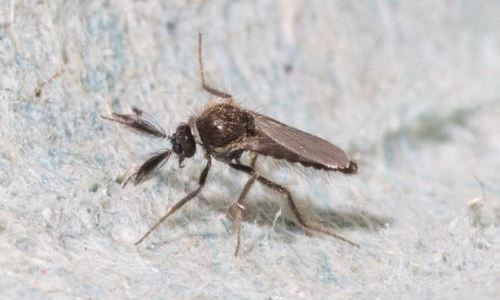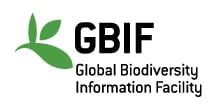Scientific Name: Ceratopogon sp Coquilllett, 1901
English Name: Biting midges
Classification:
Kingdom: Animalia
Phylum: Arthropoda
Class: Insecta
Order: Diptera
Family: Ceratopogonidae
Description:
Male: The male specimen measures 3 mm in length with wings spanning 2.5 mm. The wings are densely covered in hair. It features two subcostal cells and a third or cubital vein that ends notably before the middle of the wing, marked by a white spot at the apex of the costal vein. The halteres are white, and the metatarsi are either equal to or slightly shorter than the following joint. The antennae of the male are characterized by the last four joints being longer than the basal ten joints, with the eleventh joint approximately 1.5 times longer than any succeeding joint. The antennae are not longer than the mesonotum. The female’s head is piceous, with whitish pile on the tips of the antennae and palpi. The antennae exhibit ovate subequal joints 2-9, with joint 1 being larger and more globose. Joints 10 to 14 are ovate-oblong, with the apical joint extended into a blunt point. Each joint from 2 to 9 features two large curved transparent sense organs on the upper surface, spaced approximately 90° apart, along with smaller sense organs near the apex. Joints 13 and 14 are covered with minute organs of a similar nature. The mesonotum is dark brown and pruinose, with brassy pile, while the sides of the prothorax have yellow bristles. The pleurae are bare, and the mesopleurae are white. The abdomen is black and shining, with light yellow pile that appears reddish in certain lights. The venter is brown, and the external genitalia are subglobose and yellowish white. The legs are yellowish-brown, heavily infuscated, with yellow knees and tibiae bearing black lanceolate scales along the outer edge. The bases of the tarsi are light yellow, with the first two joints being subequal and the others shorter, each joint adorned with a graduated row of short bristles on the plantar surface. The empodium is strap-shaped and bristly-fringed, nearly as long as the claws, which are also subequal. The wing neuration includes a strong costal vein terminating distinctly before the middle of the wing, with the third or cubital vein also terminating at the apex of the costal vein.
Habitat & Distribution in Bangladesh:
Instream habitat: Larvae live in mud, debris, rotting vegetation or floating algal masses found in container habitats, water-filled tree holes, rock-pools, seepages over rock, slow flowing areas of streams or the margins of lakes.
Environment:
Freshwater, Terrestrial
Comments:
They are semi aquatic. Larvae are hatched in water. But they fly away when they got matured.
References:
Ali S, Chakraborty T (1992) BANGLADESHER MITHA PANIR AMERUDANDI PRANI (A book on Freshwater Invertebrates of Bangladesh). Bangla Academy, Dhaka, Bangladesh, ISBN: 984-07-4051-2





